Memorial To Lieutenant Colonel William Malone
Memorial To Lieutenant Colonel William George Malone NZEF
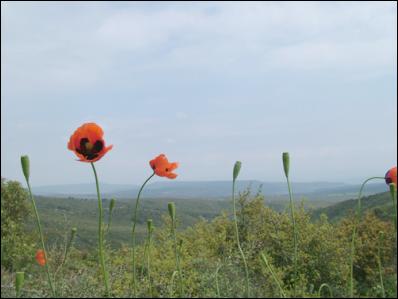
Poppies growing wild on Chunuk Bair (the Narrows can be seen in the distance)
Colour images by Scoop co-editor, Selwyn Manning. Black and white images courtesy of Alexander Turnbull Library.
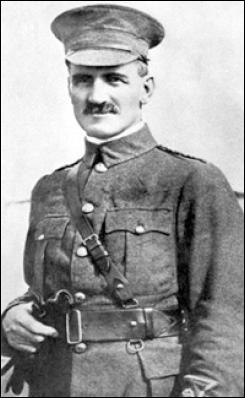 Text taken
from historical accounts: Lieutenant Colonel William
George Malone was killed in the attack on Chunuk Bair. The
Wellington Battalion was holding a line on Rhododendron
Ridge, just below the crest of Chunuk Bair, where it was
waiting for reinforcement by the Auckland Mounted Rifles,
also engaged in heavy fighting. While this reinforcement had
been making its slow and difficult advance, the Wellington
Battalion had for hours been engaged in one of the most
desperate struggles ever fought by Anzac troops. The
solitary machine-gun had been served until all its crew were
dead or wounded. There were no bombs, and for rifle
ammunition the troops had to rely on what each man had
carried and what they could get from the
dead.
Text taken
from historical accounts: Lieutenant Colonel William
George Malone was killed in the attack on Chunuk Bair. The
Wellington Battalion was holding a line on Rhododendron
Ridge, just below the crest of Chunuk Bair, where it was
waiting for reinforcement by the Auckland Mounted Rifles,
also engaged in heavy fighting. While this reinforcement had
been making its slow and difficult advance, the Wellington
Battalion had for hours been engaged in one of the most
desperate struggles ever fought by Anzac troops. The
solitary machine-gun had been served until all its crew were
dead or wounded. There were no bombs, and for rifle
ammunition the troops had to rely on what each man had
carried and what they could get from the
dead.
Col. Malone's last letter to his wife - 5th August 1915. He died on Chunuk Bair 8 August 1915.
"My Sweetheart
In less than two
hours we move off to a valley, where we will be up all night
and tomorrow in readiness for a big attack which will start
from tomorrow night. everything promises well and victory
should rest with us. God grant it so and that our casualties
will not be too heavy. I expect to go through all right but
my dear wife if anything untoward happens to me there are
our dear children to be brought up. You know how I love and
have loved you, and we have had many years of great
happiness together. If at anytime in the past I seemed
absorbed in "affairs", it was that I might make proper
provision for you and the children.
"That was due from me. It is true perhaps that I overdid it somewhat. I believe now that I did, but did not see it at the time. I regret very much now that it was so and that I lost more happiness that I need have done. You must forgive me; forgive also anything unkindly or hard that I may have said or done in the past. I have made a will and it is in the office in Stratford. I think it was justly drawn. Anyway I intended it to so to be. I hope and think that the provision for you and the children will keep you and them in ease and comfort.
"I know you will never forget or let the dear children do
so. I am prepared for death and hope that God will have
forgiven me all my sins. My desire for life - so that I may
see and be with you again - could not be greater but I have
only done what every man was bound to do in our country's
need. It has been a great consolation to me that you
approved my action; the sacrifice was really yours. May you
be consoled and rewarded by our dear Lord.
" Your
loving husband, Wm G Malone."
The following text is quoting the works of New Zealand historian Ian McGibbon:
August loomed and plans of an advance on Gallipoli’s high ground took shape with an objective to capturing Chunuk Bair, Hill Q, and Hill 971. The Australians offered a diversion at Lone Pine (seven Australians were awarded the Victoria Cross) and at dawn on August 7 an attack was launched by the New Zealanders from Chunuk Bair.
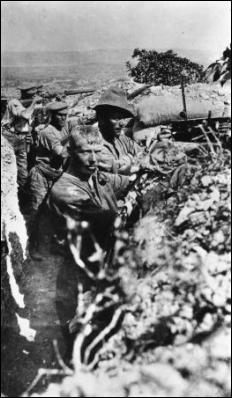
Members of the Wellington Machine Gun Section at The Apex, Gallipoli, Turkey, August 1915. The man with pipe is Robert William Dyer. Photographer unidentified.
Ian McGibbon writes: “As soon as night fell, two covering forces moved out to capture the foothills through which the assaulting columns would move to secure their objectives. On the right, the New Zealand Mounted Rifles Brigade and Otago Mounted Rifles had secured their objectives by 1 a.m. The plan thereafter came unstuck. Proceeding up separate deres (valleys), the two elements of the right assaulting column, which consisted of Johnston's New Zealand Infantry Brigade and an Indian mountain battery, were supposed to rendezvous on Rhododendron Spur before moving up on to the summit of Chunuk Bair. At dawn Johnston was still waiting at the Spur for part of his column to come up; when ordered to attack immediately he did so half-heartedly and was repulsed by the comparatively weak Turkish forces on the summit.”
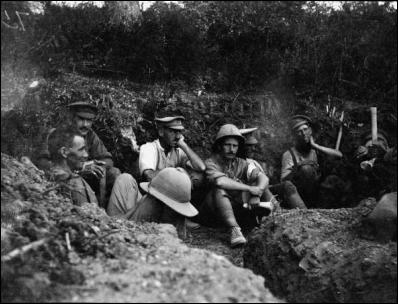
Probably soldiers of the Wellington Mounted Rifles, New Zealand Expeditionary Force, occupying a trench on Table Top, Gallipoli, during the night of August 6. 1915, in preparation for the attack on Chunuk Bair. Photograph taken by James Cornelius Read.
British and Indian troops failed to make ground over the rugged terrain in the darkness. There was to be no converging attack from Chunuk Bair. The 3rd Australian Light Horse Brigade was in effect sacrificed in the hope that the attack might help the assaulting columns up on to their objectives by distracting the enemy.
“The overall plan had depended upon speed, to ensure that the troops on the summits could consolidate their positions before the Turks could deploy their reserves in response. The delays had fatally compromised the whole offensive, though on the 8th a glimmer of hope was provided when Johnston's column found Chunuk Bair unoccupied and the Wellington Battalion moved quickly on to the summit. But the position was enfiladed by Turks on other high points, and after dawn they prevented significant reinforcements getting up to join the Wellingtons. Not until after dark did the Otago Battalion and the Wellington Mounted Rifles join them. “A further attempt to seize Hill Q was made on 9 August, but once again the whole enterprise was fatally compromised by a lack of coordination. Even so, a small force of Gurkha soldiers managed to reach the top of Hill Q, but were unable to consolidate their position before falling back after being hit by friendly naval gunfire. “By this time the weight of Turkish pressure was beginning to make itself felt, as reinforcements arrived. In desperate fighting, the New Zealanders on the summit of Chunuk Bair held off the Turks for two days. But on 10 August a massive Turkish counter-attack settled the issue. The British battalions which had relieved the New Zealanders on Chunuk Bair the previous night were swept away. The British forces on the approaches to Hill Q were also driven back,” Ian McGibbon wrote.
Mid September saw the New Zealanders withdrawn to Lemnos for rest and reorganisation. By the time they returned to Anzac in November, the future of the campaign had been sealed.
The withdrawal took place on December 19-20.
Photo-Essay: Scoop's Selwyn Manning was in Gallipoli attending the 90th commemorations of the World War I battlefield where over two thousand New Zealanders were killed.

Poppies growing wild on Chunuk Bair (the Narrows can be seen in the distance).

New Zealand Defence personnel
at parade practice at Chunuk Bair.
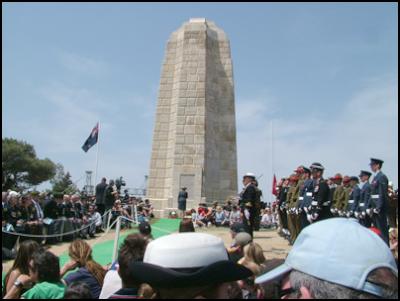
Click for big
version
Parade In Front Of Chunuk Bair
Memorial
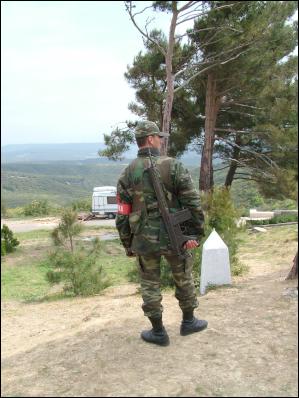
Turkish Soldier at Chunuk
Bair.
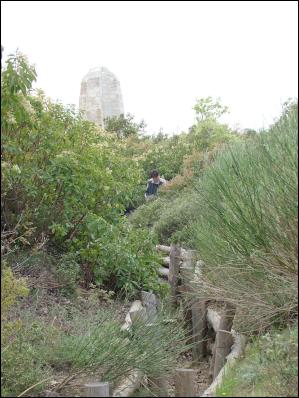
Trenches at Chunuk Bair.
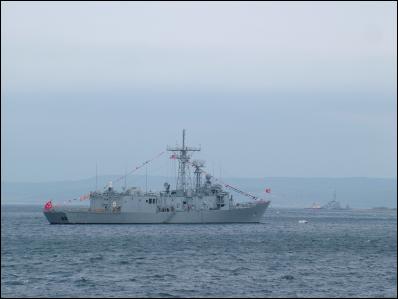
Frigate off the coast near
canakkale, Turkey.
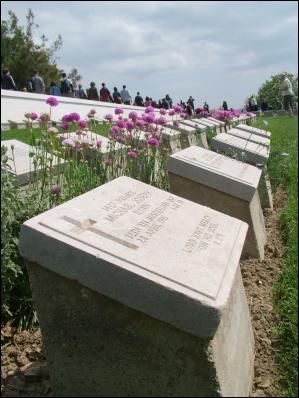
War graves atop ANZAC
Cove.
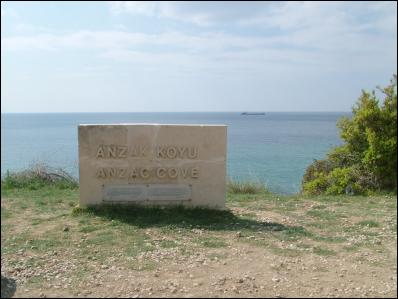
ANZAC Cove, Gallipoli.
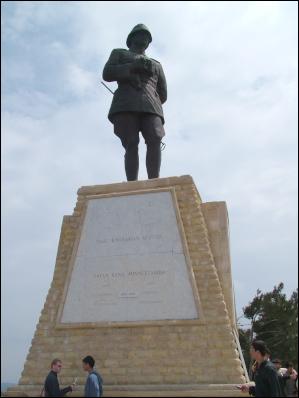
Memorial to Mustafa Kemal
Ataturk (1881-1938) the founder of the Turkish Republic and
its
first President. He masterminded the Turkish defence
of his homeland in 1915.
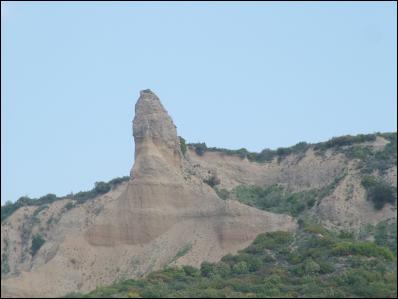
The Sphinx on the cliffs above
ANZAC Cove.
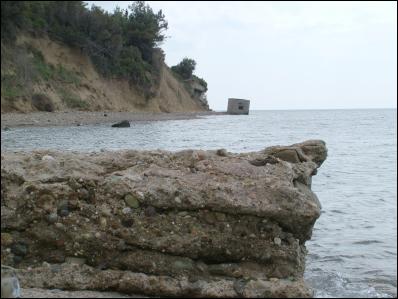
Remains of the jetty at ANZAC
Cove.

ANZAC Cove: AN Old bully-beef
can lies in the bank of a dug-out, presumed left by an ANZAC
soldier in 1915.
*******


 Richard S. Ehrlich: Deadly Border Feud Between Thailand & Cambodia
Richard S. Ehrlich: Deadly Border Feud Between Thailand & Cambodia Gordon Campbell: On Free Speech And Anti-Semitism
Gordon Campbell: On Free Speech And Anti-Semitism Ian Powell: The Disgrace Of The Hospice Care Funding Scandal
Ian Powell: The Disgrace Of The Hospice Care Funding Scandal Binoy Kampmark: Catching Israel Out - Gaza And The Madleen “Selfie” Protest
Binoy Kampmark: Catching Israel Out - Gaza And The Madleen “Selfie” Protest Ramzy Baroud: Gaza's 'Humanitarian' Façade - A Deceptive Ploy Unravels
Ramzy Baroud: Gaza's 'Humanitarian' Façade - A Deceptive Ploy Unravels Keith Rankin: Remembering New Zealand's Missing Tragedy
Keith Rankin: Remembering New Zealand's Missing Tragedy